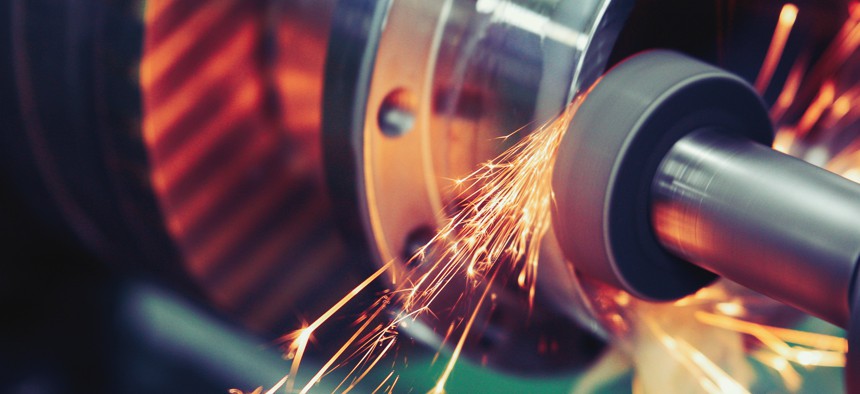The Bill That Could Truly, Actually Bring Back U.S. Manufacturing

iStock.com/nd3000
And help the climate, too
This article was originally published in The Atlantic. Sign up for their newsletter.
On paper, Cadenza Innovation is everything a modern American start-up is supposed to be.
The Connecticut-based company was founded by an award-winning Swedish chemist who first came to the United States to work at MIT. It promised a major breakthrough: lithium-ion batteries that were far less likely to explode than conventional designs. It soon found R&D support from the federal government, eager to promote an industry as essential to smartphones as to addressing climate change.
In short, Cadenza showcased every innovation-boosting feature of the American economy: its openness to immigrants, its world-leading research institutions, and its generous public research support.
Yet when it came time to mass-produce Cadenza batteries, the company looked abroad. In 2018, Cadenza licensed its technology for mass production to BAK Power, a Chinese conglomerate. It is one of at least three American companies at the frontier of battery technology that have recently licensed their work to, or been outright acquired by, Chinese firms.
“We had some discussions with U.S. manufacturers, but the battery industry in the U.S. is not strong,” Christina Lampe-Onnerud, Cadenza’s founder and chief executive, told me. “Wherever the industry is, that’s where you have to go.”
This situation ails more than just batteries. Ask yourself: Why is Tesla the only major high-tech manufacturing company to emerge from the United States in the past decade or so? Why have politicians been trying and failing since the Clinton administration to turn the U.S. into a powerhouse of clean-energy exports?
The culprit is a frustrating and persistent shortcoming of the American economy. You could call it “the manufacturing gap.” It works like this: When new technologies are in the basic research stage and decades away from reaching a market, the U.S. lavishly supports them. But when those same technologies are on the verge of commercialization and being prepared for mass production, American support drops away. No bank officer or venture capitalist will write their inventors a loan; no local manufacturing hub will help work out the final kinks in their production line.
The new technologies fall into a “valley of death” between conventional R&D and commercialization. Their inventors either license the technology abroad or go bankrupt, selling years’ worth of intellectual property for pennies on the dollar.
Over the years, this valley has only gotten wider. “Historically, what the government has done is put more money into the R&D pipeline at the top and hope that it would eventually trickle out into the market in the form of viable businesses,” Jonas Nahm, a professor of energy and environment at the Johns Hopkins University School of Advanced International Studies, told me. “But that hasn’t worked.”
This gap poses real problems for the economy and for society, and it significantly limits the country’s capacity to respond to climate change. But right now—and I almost can’t believe I’m writing this—Congress has a rare opportunity to fix it.
The decline of American manufacturing is one of those problems that everyone knows about, but that nobody seems to know how to fix. Tariffs and tax credits have failed to much improve the situation. Instead, we hear excuses: Labor is too expensive in the United States, or energy is too costly. (In fact, some of the richest countries in Europe have no problem maintaining a manufacturing sector, and the U.S. enjoys significantly lower electricity costs than China.)
Perhaps the problem is simpler: The U.S. doesn’t have a high-end manufacturing sector because nobody will finance one. Small and medium-size American companies now struggle to borrow the billions of dollars necessary to finance a new factory, especially if those loans take 10 or 20 years to pay out.
“The U.S. financial system isn’t very good at funding things that have very modest returns and take a long time for those returns to be realized,” Nahm said. You could be the most talented engineer of your generation and launch an advanced battery start-up out of MIT, he said, and you would still battle to obtain the $3 billion needed to finance a new production line. More established firms cannot access “patient capital” either, he said: Where they once would have borrowed from local banks, many of those institutions have since been absorbed into national chains.
What’s happening can be seen, in part, as a market failure. “When the research has been completed, but the technical implementation is not yet clear … there is the most uncertainty associated with investing in a technology,” Alex Williams, a research analyst at the think tank Employ America, told me.
“In many ways, Tesla’s the exception, in that it’s kind of the only manufacturing firm that has come out of Silicon Valley in decades,” Nahm added. “But they did this because Elon Musk had great personal wealth that he came in with.”
For years, the solution to the manufacturing gap has been clear to experts like Nahm: The U.S. government needs to fix this market failure, just as it fixes others. Yet that possibility seemed off the table. But recently industrial policy has become more popular across parties—Senator Marco Rubio, a Republican, has spoken favorably of it—and now a group of moderate Democratic senators, led by Senator Chris Coons of Delaware, has proposed chartering an Industrial Finance Corporation, a bank owned by the U.S. government that would fill the “manufacturing gap” and finance high-tech production nationwide.
I’ll fully break the fourth wall here and say it: I think this is a great idea and a first-rate climate policy. The IFC would have the ability to make long-term loans, buy equity, and make purchase guarantees for firms. It could do for climate-essential technologies—such as clean energy, semiconductors, batteries, and long-distance electricity transmission—what Operation Warp Speed did for COVID-19 vaccines. It could accelerate what I’ve called the “green vortex,” the mix of policy, finance, and technology that is actually driving American decarbonization.
It also has good precedent: It would work similarly to the Development Finance Corporation, a bank that bipartisan majorities in Congress authorized in 2019. The DFC is charged with making investments abroad, so its existence has put the government in the unusual position of being able to finance a new electric-vehicle factory in Slovenia—but not South Dakota. The Industrial Finance Corporation would, in essence, be its twin at home.
And the IFC is essential to addressing climate change. If the U.S. is not careful, then the manufacturing gap will stymie its attempts at decarbonization. If an American steelmaker wanted to slash carbon pollution by switching from a coal-fired furnace to an electric arc furnace, it would require tens of billions of dollars of credit on a decades-long repayment schedule. Such an investment could be in the company’s interest, the country’s interest, and the climate’s interest—but almost no bank would write that loan. The Industrial Finance Corporation could step in and provide it.
As long as it’s left to fester, the manufacturing gap will cause larger problems in the American economy. Consider that even though the U.S. outspends all other countries in R&D and has some of the world’s highest-ranked research institutions, its innovations fail to substantially improve the lives of its middle and working classes except in their role as consumers. The IFC would help fix that by creating manufacturing jobs in America.
And the manufacturing gap, too, holds back the country’s and the world’s technological progress. As I’ve written, many of the biggest improvements to a given technology happen not in a university lab, but on the factory floor, in an exchange of knowledge between engineers and machinists called “learning by doing.” The U.S. lost its lead in the solar-panel industry not because it was outspent on R&D (it wasn’t), but because it outsourced solar production abroad and failed to build up expert ecosystems of inventors, designers, and workers. The same dynamic has played out in the semiconductor industry, Williams said. Technological improvement is, in short, a far more democratic process than our current system gives it credit for.
The lack of those tight networks in the U.S. is ultimately why Cadenza manufactured its batteries abroad. “Even if you have a chance to deploy, you’re not surrounded by an ecosystem,” Lampe-Onnerud said. “Unless you’re willing to do Asia calls every night and work a U.S. day, you’re out of the loop.”
She agreed that the U.S. could benefit from a more manufacturing-forward policy. And she suggested that the U.S. will ultimately benefit from Cadenza’s partnership with BAK. “Now we have experience from a leading Chinese company that we can bring here,” she said. “Climate change doesn’t have a passport. Pragmatically, we must find ways to collaborate.”
But one way that the U.S. can collaborate with the world is building innovative ecosystems of its own. The IFC could pull together America’s messy set of clean-energy and industrial policies into a coherent whole. I hope that lawmakers see it as an essential part and include it in the Democratic reconciliation bill.
Nahm, who studies how clean-energy industries developed in China—and who, for the record, had not heard about the bill until I texted it to him—agrees. “In principle, I think this approach is so much better than what we’ve been doing,” he told me. “This would be, like, a real game changer.”
Robinson Meyer is a staff writer at The Atlantic.

NEXT STORY: Some 'Most Impressive' Law School Applicants Are Convicted of Serious Crimes






